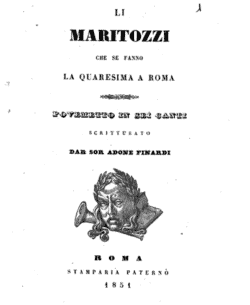Either stuffed with whipped, fresh, and sweetened cream or filled up with salty dressing, maritozzo is a local treasure almost as ancient as Rome. Maritozzo is the name of a sweet bun whose origins date back to Ancient Rome when women used to prepare loaves for their husbands who stayed far from home all day. A loaf was put into the men’s saddle bags who ate it when taking a break from their work in the fields. Flour, eggs, butter, honey, and salt were the main ingredients of the dough, which was sometimes enriched with dried fruits.
 This tradition was passed on from generation to generation. It seems that in the Middle Ages, during Lent, women prepared a slightly different version of these loaves: smaller, made with oil instead of butter, and with the addition of pine nuts, raisins, and candied fruits. Today’s maritozzo is likely to derive from this traditional Lenten cake, one among the few Catholics were allowed to eat in this period of prayer and fasting. As a matter of fact, Lent is for Catholics a transitional period that starts immediately after Carnival and lasts 40 days during which fasting is demanded so as to prepare body and soul to the celebration of Easter. Notwithstanding this, a day called “Mid-Lent” was established when people could temporarily stop their abstinence from consuming certain foods; thus, some special cakes came up in each Italian region and maritozzo was the one peculiar to Lazio, especially Rome.
This tradition was passed on from generation to generation. It seems that in the Middle Ages, during Lent, women prepared a slightly different version of these loaves: smaller, made with oil instead of butter, and with the addition of pine nuts, raisins, and candied fruits. Today’s maritozzo is likely to derive from this traditional Lenten cake, one among the few Catholics were allowed to eat in this period of prayer and fasting. As a matter of fact, Lent is for Catholics a transitional period that starts immediately after Carnival and lasts 40 days during which fasting is demanded so as to prepare body and soul to the celebration of Easter. Notwithstanding this, a day called “Mid-Lent” was established when people could temporarily stop their abstinence from consuming certain foods; thus, some special cakes came up in each Italian region and maritozzo was the one peculiar to Lazio, especially Rome.

Nowadays, maritozzo is served either with sweet or salty dressing: the classic one is stuffed with whipped cream, but you can taste it also with ice cream, especially in summertime. Instead, the most popular savoury option is maritozzo filled with burrata (creamy cheese made from mozzarella) and anchovies.
There are several stories concerning the origins of the name of this sweet bun. Romans called it “er santo maritozzo” (literally, “the holy maritozzo”) and legend has it that on the 1st of March – that was a sort of Valentine’s day – young lovers used to give one to their girlfriends, often with a ring hidden inside: a gift for their brides-to-be. In fact, the word ‘maritozzo’ is an affectionate form of the Italian word for husband, marito.
 Adone Finardi, instead, in his short poem in six cantos Li maritozzi che se fanno la Quaresima a Roma (“Maritozzi that are made in Rome for Lent”, 1851), narrates the deeds of two rival kings, Mari and Tozzi, and their soldiers. The two kings are longstanding enemies and end up fighting each other: Passerina (raisin), Fiore (flour), Cannito (candided fruits), Legna (firewood), Acqua (water), and Forno (oven) fight in king Mari’s army while Pignolo (pine nuts), Zibibbo (that is the name of a sweet wine), Zuccaro (sugar), and Lievito (yeast) are at the service of king Tozzi. Lately, Mari and Tozzi decide to put an end to their war: Pignolo and the brave warrior Passerina fall in love and get married, while the kings decide to immortalize the event. They proclaim they will reward anyone who creates something that can be passed on to the next generations: so a cook invents some pastries kneading flour, sugar, water, and yeast, then adding raisins, zibibbo, and candied fruits. Finally, he bakes the pastries in a wood-burning oven and calls them after the two kings’ names: Mari+Tozzi.
Adone Finardi, instead, in his short poem in six cantos Li maritozzi che se fanno la Quaresima a Roma (“Maritozzi that are made in Rome for Lent”, 1851), narrates the deeds of two rival kings, Mari and Tozzi, and their soldiers. The two kings are longstanding enemies and end up fighting each other: Passerina (raisin), Fiore (flour), Cannito (candided fruits), Legna (firewood), Acqua (water), and Forno (oven) fight in king Mari’s army while Pignolo (pine nuts), Zibibbo (that is the name of a sweet wine), Zuccaro (sugar), and Lievito (yeast) are at the service of king Tozzi. Lately, Mari and Tozzi decide to put an end to their war: Pignolo and the brave warrior Passerina fall in love and get married, while the kings decide to immortalize the event. They proclaim they will reward anyone who creates something that can be passed on to the next generations: so a cook invents some pastries kneading flour, sugar, water, and yeast, then adding raisins, zibibbo, and candied fruits. Finally, he bakes the pastries in a wood-burning oven and calls them after the two kings’ names: Mari+Tozzi.
Whatever the origin of the name, maritozzi are still very popular today and people love having it in the morning with an espresso or a cappuccino. Moreover, a Roman culinary association established the maritozzo day some years ago, an event where it is possible not only to taste maritozzo in its endless variations, but also to contribute to special fundraising.
Sources:
Accademia italiana di gastronomia e gastrofisica, Storia panino maritozzo salato o dolce. https://www.taccuinigastrosofici.it/ita/news/contemporanea/panini-e-cibo-di-strada/maritozzi-dellamore.html
Aleteia, Do you know what Mid-Lent is? https://aleteia.org/2017/03/14/origins-mid-lent-when-what-why-laetare-sunday/
Arieti, Italo. Tuscia in tavola. Ricette, curiosità, prodotti, tradizioni gastronomiche della provincia di Viterbo. Viterbo: Primaprint editori, 2009.
Associazione italiana foodblogger, Il maritozzo. Giornata nazionale del maritozzo. https://www.aifb.it/calendario-del-cibo/giornata-nazionale-del-maritozzo/
Delicious Italy, A history of love for the maritozzo. https://www.deliciousitaly.com/lazio-rome-food-wine/a-love-for-the-maritozzo-of-rome
Finardi, Adone. Li maritozzi che se fanno la Quaresima a Roma. Povemetto in sei canti. Roma: Stamparia Paternò, 1851. https://books.google.it/books?id=nFVZKcLzQCAC&pg=PA1&hl=it&source=gbs_toc_r&cad=4#v=onepage&q&f=false
Gordan, Lucy. “Maritozzo: Rome’s Only Native-Son Sweet Gets Its Own Celebration”. https://www.lavocedinewyork.com/en/food/2019/12/02/maritozzo-romes-only-native-son-sweet-gets-its-own-celebration/
Maritozzoday, edition 2019, https://youtu.be/II8zuc4FGdg
Maritozzoday, Il maritozzo: storia e tradizioni. https://maritozzoday.tavoleromane.it/maritozzo/maritozzo-storia-tradizioni/
Rachel Rodney, “Rachel Roddy’s recipe for marotozzi cream bun”, The Guardian. https://www.theguardian.com/food/2020/mar/16/rachel-roddy-maritozzi-cream-buns-recipe
Written by Alberta Boschi, PhD student in “European Languages and Specialized Terminology” at the University of Naples “Parthenope” (Italy)

